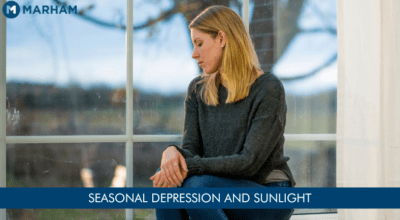Do you feel down and gloomy in the winter evenings? Is it difficult for you to get out of your bed in the cold mornings of January? Do you think your depressed state is somehow related to winters? For your information, let me tell you seasonal depression is real! And you might be one of those individuals who suffer from this condition when the cold winter breeze arrives.
What is seasonal affective disorder?
Seasonal depression, seasonal affective disorder, or winter blues are names for a similar condition with multiple symptoms like depression. Some of the most common symptoms of seasonal depression are loss of energy, lack of appetite, tendency to oversleep, difficulty concentrating, and irritability. It occurs at the same time every year.
What causes seasonal affective disorder?
Seasonal affective disorder (SAD) is a type of depression triggered by a change in the seasons, usually when autumn begins. SAD worsens in the winter and then subsides in the spring. According to the American Academy of Family Physicians, seasonal affective disorder affects between 4% and 6% of the population.
Did you know? Some people suffer from a rare form of seasonal affective disorder known as “summer depression.” It begins at end of spring or early summer and lasts until the fall.
SAD is more common among women and younger people. You are also more likely to develop seasonal depression if you have other mood disorders such as major depressive disorder or bipolar disorder or relatives who suffer from other mental illnesses, such as depression or schizophrenia.
Living in high latitudes (north of the equator), such as Alaska or New England, in cloudy areas can also be the reason behind this condition.
Seasonal affective disorder can coexist with other mental illnesses such as anxiety disorder, attention deficit hyperactivity disorder (ADHD), eating disorder, and anxiety disorder.
What are the symptoms of seasonal depression?
Seasonal depression is a subtype of depression, not a distinct mental disorder. People suffering from seasonal affective disorder may exhibit signs of depression, such as:
- Sadness
- Anxiety
- Loss of interest in routine activities, including withdrawal from social activities
- Cravings for carbohydrates and weight gain
- Irritability
- Feeling of heaviness in the limbs
- Sleep problems
- Extreme exhaustion and a lack of energy
- Feelings of worthlessness or hopelessness
- Inability to concentrate
- Suicidal or death-related thoughts
What are the causes of seasonal depression?
Researchers are not sure what causes seasonal depression. According to the theories, a lack of sunlight may trigger people that are predisposed to the condition.
-
Imbalance of chemicals in the brain:
Neurotransmitters, which are chemicals in the brain, establish the communication between nerves. Serotonin, which contributes to feelings of happiness, is one of these chemicals. So, people who are predisposed to SAD may already have lower serotonin in their bodies. Because sunlight helps regulate serotonin, a lack of sun can exacerbate the situation in winters. Serotonin levels can drop even further, causing mood swings.
-
Biological clock shift:
When people are exposed to less sunlight, their biological clock changes, this internal clock is in charge of regulating mood, sleep, and hormones. People may have difficulty managing their emotions when it changes.
-
Vitamin D deficiency:
Vitamin D also boosts serotonin levels. Because sunlight aids in vitamin D production, a lack of sunlight during winters can result in a vitamin D deficiency. This alteration can have an impact on serotonin and mood.
-
Boost of melatonin:
Melatonin is a chemical that influences sleep patterns. A lack of sunlight may cause an overproduction of melatonin in some people. During the winters, they may feel sluggish and sleepy.
-
Negative emotions:
People suffering from SAD frequently experience stress, anxiety, and negative thoughts. Researchers are unsure whether these negative thoughts are a cause or a result of seasonal depression.
How to treat seasonal depression?
Although the causes of seasonal affective disorder are unknown, the treatment is simple: more light during the winter months. People with seasonal depression may benefit from antidepressant medications in severe cases.
Seasonal depression and sunlight:
Thirty minutes of exercise in the morning in bright sunlight helps overcome the winter blues. Phototherapy is another treatment option. Using a unique lamp, bright light therapy can treat seasonal depression.
Getting sunlight boosts your serotonin levels and helps you avoid seasonal affective disorder (SAD). It can also help people with anxiety and depression, especially when combined with other treatments.
Book an appointment now to answer all your queries related to seasonal affective disorder. You can book an appointment with the top psychologists in Lahore through Marham by calling the Marham helpline: 0311-1222398 or by online booking facility through the website or Marham mobile app.
FAQs
1. What is seasonal depression?
Seasonal depression is a type of depression that is triggered by a change in the seasons, usually when autumn begins. This SAD worsens in the winter and then subsides in the spring.
2. Is my depression related to winter?
Yes, seasons like autumn and winter can cause a depression known as seasonal depression.
3. Can sunlight treat my seasonal depression?
Yes, sunlight helps in boosting the amount of serotonin and treat seasonal depression.

